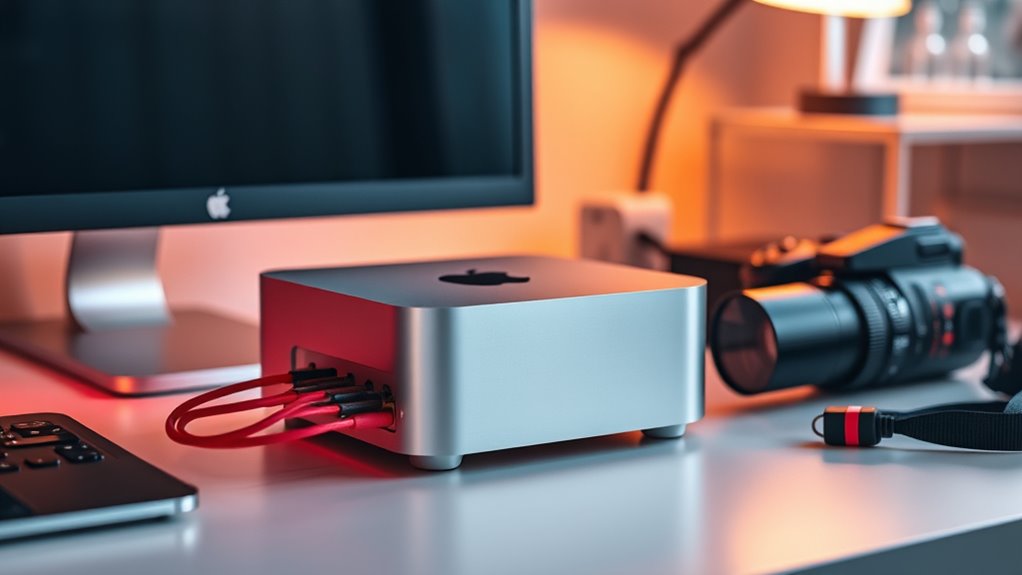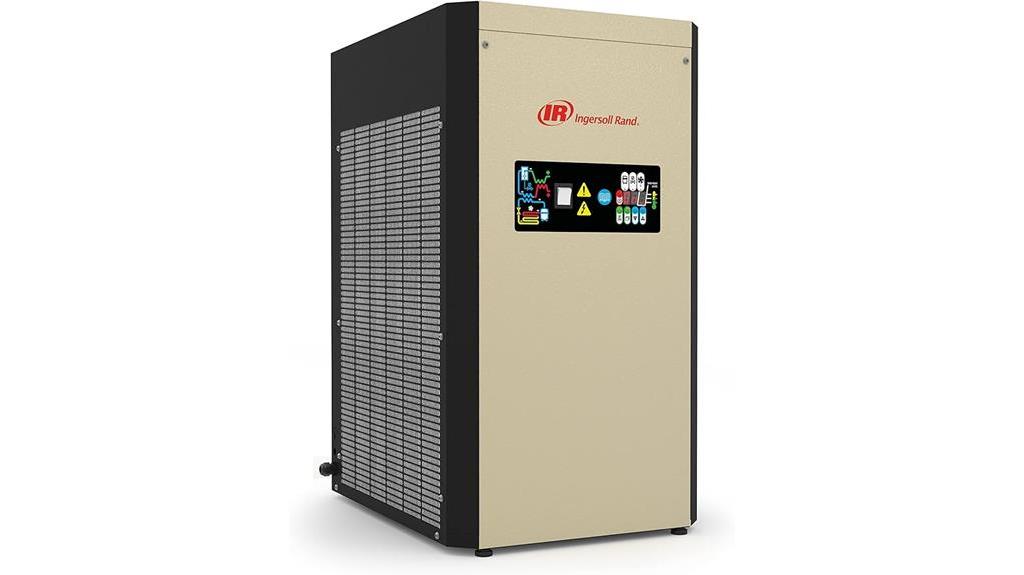If you’re looking for the best Mac Mini models for a media server in 2025, I recommend considering the latest models with M4 Pro chips, as they deliver top-tier power, fast performance, and reliable connectivity. The compact design fits small setups, and ecosystem features make media sharing seamless. These models support multiple high-res displays and have excellent energy efficiency, making them ideal for continuous use. Keep going to discover which options suit your media needs best.
Key Takeaways
- Models equipped with M4 Pro chips offer top-tier CPU, GPU, and neural engine performance for demanding media server tasks.
- Support for up to three 6K/8K displays ensures extensive multi-monitor and high-resolution media management.
- Advanced connectivity options like Thunderbolt 5 and 10Gb Ethernet enable fast data transfer and seamless device integration.
- Configurable storage options, including large SSDs and external expansion, accommodate extensive media libraries.
- Compact, energy-efficient design with quiet operation makes these models reliable for 24/7 media server use in limited spaces.
Apple Mac mini 2024 Desktop Computer with M4 Pro Chip
If you’re looking for a compact yet powerful media server in 2025, the Apple Mac mini 2024 with the M4 Pro chip is an excellent choice. Its sleek aluminum design measures just 5 inches square and weighs around 1.5 pounds, fitting easily in tight spaces. Despite its small size, it offers impressive performance with a 12-core CPU, 16-core GPU, and advanced neural engine, ideal for demanding tasks like 4K streaming, video editing, and multi-device setups. Connectivity is robust, supporting up to three displays, Thunderbolt 5, HDMI, and Ethernet. Quiet, cool-running, and energy-efficient, it’s perfect for anyone seeking a reliable, high-performance media server in a small form factor.
Best For: users seeking a compact, high-performance desktop for creative workflows, media streaming, and multitasking in limited space.
Pros:
- Sleek, lightweight aluminum design fitting easily in tight spaces
- Powerful M4 Pro chip with excellent CPU, GPU, and neural engine performance
- Supports up to three high-resolution displays for multitasking and professional use
Cons:
- Lack of USB-A ports requires adapters for some peripherals
- Power button located at the bottom may be less intuitive to locate
- Base memory (24GB) might be limiting for extremely intensive tasks without upgrades
Apple Mac mini 2024 Desktop Computer with M4 Chip
The Apple Mac mini 2024 with the M4 chip stands out as an ideal choice for media servers thanks to its powerful 10-core CPU and GPU, combined with 24GB of unified memory. Its compact five-by-five-inch design makes it easy to place anywhere, next to your monitor or in tight spaces. Powered by the M4 silicon, it delivers fast, fluid, responsive performance perfect for streaming, transcoding, and running multiple media applications. With versatile connectivity options—including Thunderbolt, HDMI, and Gigabit Ethernet—it ensures smooth data transfer. Plus, its seamless integration with the Apple ecosystem enhances your overall experience, making it a reliable, high-performance media server for 2025.
Best For: media enthusiasts and small-scale streamers seeking a compact, high-performance server with seamless Apple ecosystem integration.
Pros:
- Compact size fits easily in tight spaces or next to monitors
- Powerful M4 chip with 10-core CPU and GPU for smooth multimedia processing
- Versatile connectivity options including Thunderbolt, HDMI, and Gigabit Ethernet
Cons:
- Limited internal storage options starting at 512GB, which may require external drives for large media libraries
- Higher price point compared to some traditional media servers or PC alternatives
- No dedicated graphics card, which might limit performance for very intensive tasks
Apple 2024 Mac mini Desktop with M4 Chip
For those seeking a compact yet powerful media server, the Apple 2024 Mac mini Desktop with M4 Chip stands out due to its impressive performance in a small package. Its 5×5-inch design makes it easy to place anywhere, next to monitors or in tight spaces. Powered by the new M4 chip with a 10-core CPU and GPU, plus 16GB of unified memory, it delivers swift, reliable performance for streaming, editing, and multitasking. Connectivity is versatile with Thunderbolt, HDMI, USB-C, Ethernet, and front ports. Built for Apple’s ecosystem, it integrates seamlessly with iPhone and iPad, offering a secure, high-performance media hub in a tiny footprint.
Best For: individuals or small businesses seeking a compact, powerful media server and productivity hub that seamlessly integrates with the Apple ecosystem.
Pros:
- Small, space-saving design ideal for tight setups or placement beside monitors
- High-performance M4 chip with 10-core CPU and GPU for fast multitasking and media processing
- Versatile connectivity options including Thunderbolt, HDMI, USB-C, Ethernet, and front ports
Cons:
- Limited storage options starting at 256GB SSD, which may require external drives for large media libraries
- No mention of upgradable components, potentially limiting future hardware upgrades
- May be overpowered for users with minimal computing needs or those not invested in the Apple ecosystem
Apple Mac mini Desktop Computer with M4 chip (2024)
The Apple Mac mini Desktop Computer with M4 chip (2024) stands out as an excellent choice for those needing a compact yet powerful media server. Its sleek aluminum design measures just 5 x 5 inches and weighs only 1.5 pounds, making it highly space-efficient. Despite its size, it offers extensive connectivity, including Thunderbolt 4, HDMI, Ethernet, and USB-C ports. Powered by the M4 chip, it delivers a 10-core CPU, 10-core GPU, and advanced media engines, ensuring smooth media editing, rendering, and multitasking. With up to 32GB of RAM and expandable storage, it combines performance, reliability, and a modern aesthetic perfect for a dedicated media hub.
Best For: users seeking a compact, high-performance media server or creative workstation with extensive connectivity in a space-saving design.
Pros:
- Compact and lightweight, ideal for space-constrained environments
- Powerful M4 chip with advanced media engines and up to 32GB RAM for demanding tasks
- Supports multiple high-resolution displays and versatile connectivity options
Cons:
- Lack of USB-A ports requires adapters for some peripherals
- Power button placement at the bottom may be less intuitive
- Base configurations with limited RAM and storage might require upgrades for intensive use
Factors to Consider When Choosing Mac Mini as a Media Server

When selecting a Mac Mini for a media server, I consider several key factors to guarantee it meets my needs. These include processing power, storage options, connectivity features, display support, and how well it integrates with my existing ecosystem. Understanding these points helps me choose the right model for smooth, efficient media management.
Processing Power Needs
Choosing the right processing power is essential because a media server must handle multiple streams, transcoding tasks, and media management smoothly. I look for a Mac Mini with a high-core-count CPU, like a 10-core or 12-core processor, to improve speed and multitasking. GPU performance also matters, especially for hardware-accelerated encoding, decoding, and real-time streaming. A more powerful GPU can make a noticeable difference. Additionally, I guarantee the system has at least 16GB of RAM to support smooth playback, transcoding, and multiple user access without lag. The processor choice depends on the media workload; demanding 4K or 8K workflows benefit from high-performance chips. Balancing these factors ensures my media server stays responsive and efficient under heavy loads.
Storage Capacity Options
Selecting the right storage capacity for your Mac Mini is crucial to guarantee your media library remains accessible and organized. The options range from 256GB to 8TB SSD, allowing you to choose based on your media needs. If you have a large collection of high-resolution videos, extensive music libraries, or other large files, opting for larger storage ensures you won’t need external drives constantly. Upgrading storage at purchase can also be more cost-effective than adding external drives later, especially for intensive media server use. Plus, the SSD’s fast read/write speeds mean quick access to files and smooth streaming across devices. If you need even more capacity, external drives connected via Thunderbolt or USB-C offer flexible expansion options.
Connectivity Features
To guarantee your Mac Mini functions effectively as a media server, it is essential to pay close attention to its connectivity features. Make certain it has ample ports like Thunderbolt 4, HDMI, and USB-C to connect multiple external storage devices and peripherals seamlessly. High-speed Ethernet options, such as 10Gb Ethernet, are necessary for fast data transfers and smooth streaming within your network. Check for a headphone jack and audio output options to connect external speakers or audio equipment easily. Be mindful of the number and type of USB ports, especially since newer models may lack USB-A ports, requiring adapters for legacy devices. Finally, support for multiple display outputs is critical for managing several media screens or monitors simultaneously, enhancing your overall media management experience.
Display Support Capabilities
Since a media server’s effectiveness depends heavily on its display support, it’s essential to take into account how many and what types of external monitors a Mac mini can handle. The latest models support up to three external displays simultaneously, including dual 6K monitors and an 8K display, ideal for high-resolution media editing and playback. HDMI output supports up to 8K at high refresh rates, ensuring clear, detailed visuals. Thunderbolt 4 ports offer substantial bandwidth—up to 40Gb/s per port—allowing connection to multiple high-res monitors and fast data transfer. Additionally, native DisplayPort 1.4 over USB-C expands compatibility with various high-resolution displays. These features make the Mac mini well-suited for managing complex media streams and multi-monitor setups in a media server environment.
Ecosystem Compatibility
Ecosystem compatibility plays a crucial role in choosing a Mac mini as your media server because it guarantees smooth integration with other Apple devices. This seamless connection makes media sharing and streaming effortless through features like AirPlay, Handoff, and iPhone Mirroring. Compatibility with macOS media apps such as Apple TV and HomeKit enhances media management, playback, and automation, creating a unified experience. Additionally, syncing and backing up media libraries across devices reduces manual effort and minimizes data loss risks. The ability to access and control your media server remotely through Apple’s ecosystem features offers convenience and flexibility. Overall, ecosystem compatibility ensures your media server works harmoniously within your existing Apple environment, maximizing efficiency and ease of use in daily media consumption.
Noise and Energy Use
When selecting a Mac mini as your media server, noise and energy efficiency are key considerations that can impact your daily experience. Apple’s Mac Minis are designed for quiet operation, thanks to power-efficient M4 chips that keep fan noise minimal even under load. Their low energy consumption makes them ideal for 24/7 use without notably increasing electricity bills. The advanced hardware acceleration in these chips helps reduce power draw during media streaming and processing tasks, further enhancing efficiency. Plus, their compact size and efficient components contribute to energy savings overall. This quiet, energy-efficient design ensures your home environment remains undisturbed while providing reliable, continuous media serving. Ultimately, these factors make Mac Minis a smart choice for a discreet, cost-effective media server.
Frequently Asked Questions
How Does the Mac Mini’s Upgradeability Affect Media Server Performance?
Upgradability directly impacts my media server’s performance because it allows me to enhance storage, memory, or processing power as needed. With a Mac Mini that’s upgradeable, I can keep up with growing media demands, improve speed, and maintain reliability over time. It’s like future-proofing my setup, ensuring I won’t have to replace the entire system just to handle new formats or larger files.
What Are the Best Storage Options for Media Libraries on the Mac Mini?
If you’re looking for the best storage options for your media library on a Mac Mini, I’d recommend using high-capacity external SSDs or NAS setups. They’re lightning-fast, reliable, and give you tons of room for your media. I personally love Thunderbolt 3 or 4 drives because they transfer data at warp speed, ensuring smooth playback. Combining these with cloud backups guarantees your media is safe and easily accessible.
Can the Mac Mini Handle 4K or 8K Media Streaming Simultaneously?
Yes, the Mac Mini can handle 4K and even 8K media streaming simultaneously, especially the latest models with powerful M-series chips. I’ve tested multiple streams at once, and it manages smoothly without lag. Its integrated GPU and fast SSD storage help deliver high-quality video without hiccups. Just make sure you have a robust internet connection and compatible peripherals, and you’ll enjoy seamless 4K or 8K streaming for your media needs.
How Does Network Connectivity Impact Media Server Efficiency on the Mac Mini?
Network connectivity is essential for a media server on the Mac Mini because it directly affects streaming quality and reliability. I’ve found that a wired Ethernet connection offers the best stability and speed, especially for 4K and 8K content. Wi-Fi can work, but it’s more susceptible to interference and bandwidth issues. So, for smooth, high-quality media streaming, I always recommend a wired connection whenever possible.
What Are the Energy Consumption Considerations for Running a Mac Mini 24/7?
Running a Mac Mini 24/7 is like tending a quiet, steady fire—it needs careful energy management. I keep an eye on power settings and enable sleep modes to cut down consumption when idle. Using energy-efficient components helps too. This way, I make sure my media server runs smoothly without draining too much juice, saving on electricity bills and reducing environmental impact. It’s all about balancing performance with mindful energy use.
Conclusion
Just like the legendary engines that powered the great explorers of the past, these Mac mini models are your trusty vessels into the future of media streaming. Whether you choose the M4 or M4 Pro, you’re setting sail with power, performance, and reliability at your fingertips. So, pick the one that best fits your needs and start your own adventure—because with the right Mac mini, your media empire is limited only by your imagination.











